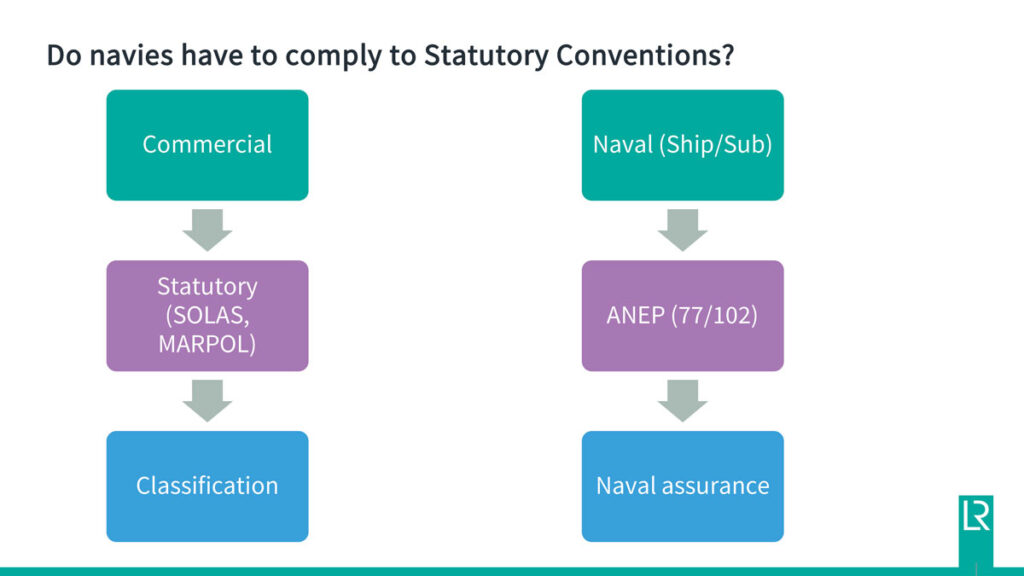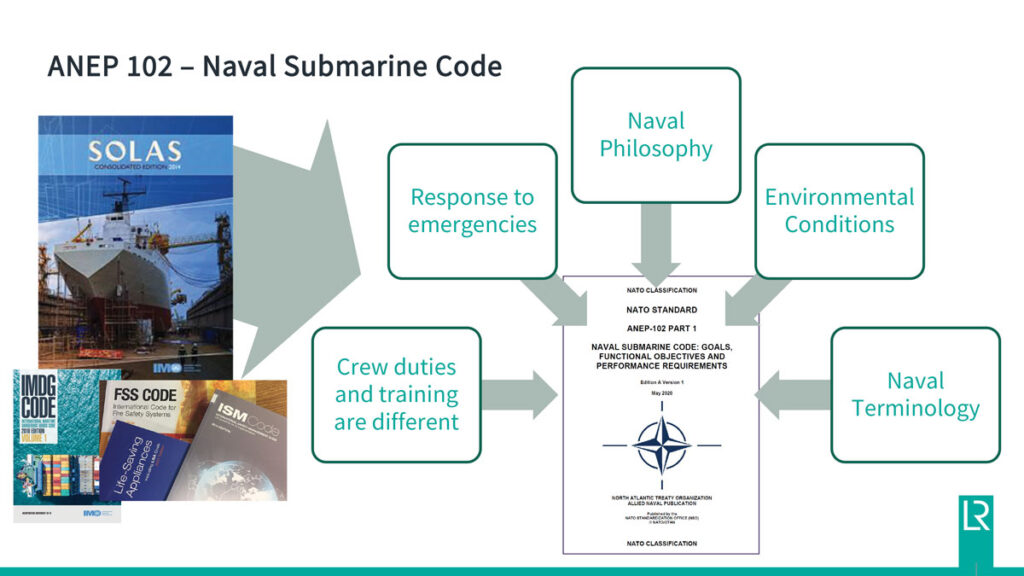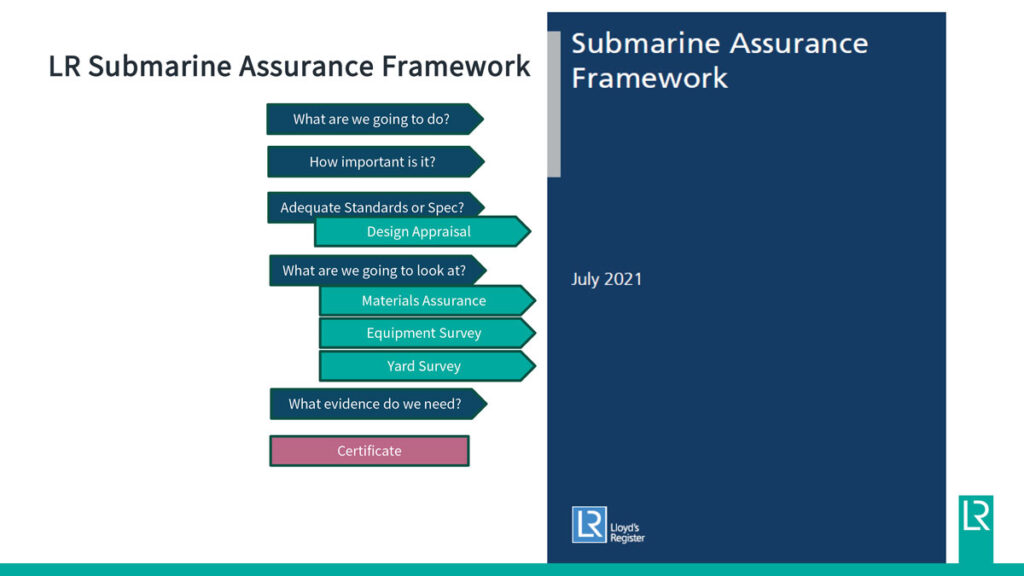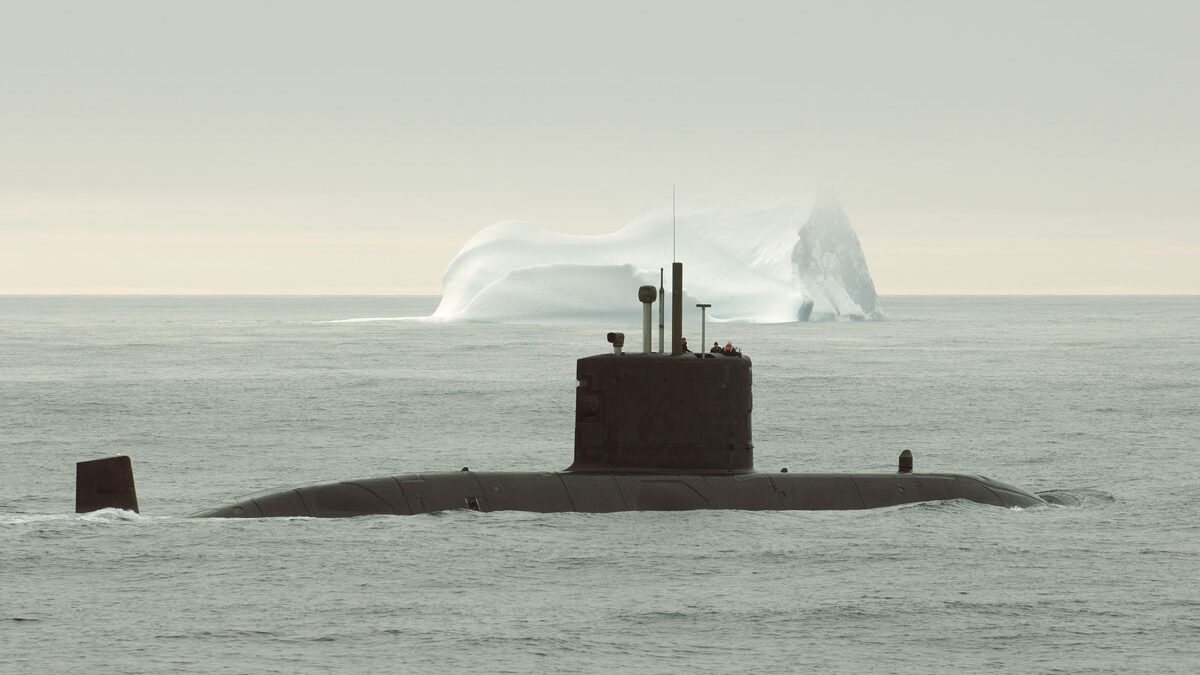
MARK RUSSELL
CD BEng MSc PEng PRINCIPAL NAVAL ARCHITECT, BMT

RADM LUC CASSIVI
CMM, CD, RCN (RET’D)

MATTHEW PALMER
CEng, GLOBAL NAVAL BUSINESS LEAD, SUBMARINES AND UNMANNED SYSTEMS, LLOYD’S REGISTER
Among the many fascinating session at Deep Blue 2023 in Ottawa was the waste disposal and management panel. The panel spoke about the importance and evolution of onboard environmental Systems for submarines, covering food, storage, bilge holding capability to grey and black water waste disposal. It also looked environmental regulations (MARPOL, including Arctic Annex). Below is a condensed version of the discussion, edited for clarity.
LUC CASSIVI: Greetings to the panel and thank you everyone. So, why waste management? To get the conversation going: there are some realities in the Arctic that we must acknowledge as we move forward. We talk about north of 60, and that’s where the focus is going to be. Infrastructure in the Arctic is a challenge. But there’s other realities we deal with – upgrading propulsion and power generation systems that enables you to extend your short cycles beyond what we’ve traditionally had. Other forms of vulnerabilities also become critical, to minimize counter detection, for example. They enable you to do more, to stay in the fight longer and to minimize risk of counter detection.
It’s also important for the crew on how you design it. I know that the trainee that waited for a year to get a bunk in the weapon handling compartment but was probably slightly disappointed during the first set of domestic routines when the vent to the sewage tank was venting above their bunk.
So, there’s a lot to be done still to make things better from health and safety, sanitation and reduce maintenance requirement on the crew, and to be able to operate in lengthy patrol.

MATTHEW PALMER: Thank you. I want to talk to you from a class society perspective about waste and why waste is important and how we provide assurance of those waste systems (Figures 1, 2).
The first question is: Do navies have to comply to Statutory Conventions? And the answer is no, they don’t. They have an exemption from the governments. They don’t have to comply. What they do is have to show that they can get as close as possible through equivalences.
I’m not going to focus too much on ship side, I’m going to focus on the submarine code. The codes were created as a kind of naval equivalent to statutory conventions of how to comply. If you paint a ship grey, you can call it a warship. And it’s obvious how you can comply with a submarine. You don’t have a commercial naval submarine. It’s harder to show compliance that way. So, the codes were created to show the special, unique operating things that only naval assets do and that commercial assets don’t do. And it’s all put into that document.

Over the past few years, we’ve seen a big, discussion of what compliance looks like. We have one side of the fence that says you should just comply with MARPOL. The other side says, actually, we can’t comply with MARPOL. We’re too old, or our de- sign won’t let us comply. We can’t put an oil water separator in, or our grey water tank is too small. We need to discharge it. That’s how we can keep operating.
So INSA created some environmental guidelines that looked at all the annexes and MARPOL and wrote some naval interpretations of ways Navies could apply areas they need to think about and if you could follow MARPOL It’s that kind of under- standing, creating that different pathway. And this is something that we could use in next Canadian submarines – actually using this to benchmark and showing regulators how we’re complying. Showing how we are using these naval interpretations in these areas, but in these areas we are actually complying with MARPOL and breaking it down as well.
But how do we verify against this and give the evidence to the maintainer and to the Navy to say actually this is how you meet it?
With submarines, it’s harder to actually do what that benchmark is. One of the reasons for that is secrecy. Secrecy is key for submarines. As there’s not that many submarines out there to create a big rule set that can be maintained. So, what we’ve had to do is deconstruct the class process. Like when you go to a fancy restaurant and they do a deconstructed meal, they take the elements out and put them in a different order.
When I do a course the first question I ask of the group is what’s the difference between a ship and a submarine? It seems obvious. Ships aren’t designed to go underwater and once you start teasing out those issues, it starts that thought process generating of how you provide assurance, especially if we’re looking in the context of waste management systems.
It was mentioned previously that a sub- marine’s number-one priority is stealth. Everything else comes second to stealth. And your space is limited on board. So, modifications are difficult because you increase the weight of submarine, which has consequences.
It’s understanding how these systems can be tailored to fit in and provide that assurance. And you’re showing equivalence to MARPOL that way.
We’ve looked at a kind of goal-based framework of the Naval submarine code and we’ve come up with the Naval submarine assurance framework, which is a goal- based code that sits in between the goals of the submarine code and the verification space (Figure 3).

It’s the part two solutions that you don’t see in the submarine code because of sub- marines and secrecy. So effectively it’s a glorified question set. And those kinds of questions are split between process and technical. If I’ve got an oil order to separate, it’s Commercial off-the-shelf (COTS). Got it. I put it in commercial ships, but can I put it in a submarine? Going through this process is a way of justifying, actually yes, I can put it in that submarine based on the operating conditions that you’ve put in your concept of operation statement. I actually need to make some modifications to that system, and now the oil water separated becomes more Military off-the-shelf (MOTS) then COTS, but it gives a spec that Lloyd’s Register can verify to and is sue certification on, which goes back to the regulator to show where environmental compliance goes back to. And we’re saying we are on the pollution there and this is how we control it. So, it’s building into that process, but it very much kind of works on what the principles are of the naval submarine code.
As I mentioned, it’s a glorified question set. So, the first thing is, what is it, what are you going to do? How important is it? If you’ve got a system with a haul valve, how important is it if that haul valve fails, water comes into the boat, do you lose the boat? It’s asking the questions, the criticality of the systems, and setting that kind of standard that you’re looking for. What specification are you using? Are you talking about the oil water separator? Are you using COTS spec or are you using a Canadian naval standard or another country’s naval standard as your specification? And then you go through the processes of de- sign appraisal, equipment survey, and then yard survey and bring it in there as well.
When we talk about standards, we want to know, is that standard the right standard? If you’ve always used that naval standard because it’s an old standard, is it still relevant or do you need to do a standard justification where you are tailoring commercial requirements into that naval standard to make a kind of hybrid blended solution to show “this is how I’m showing compliance, and this is how you can certify against it?”
Submarine projects come along once every 20 years, it’s about trying to store that design intent of why something was done and the justification. So, you can go back to the reasoning. This is going to get my spec for the new piece of kit that needs to replace what is now obsolete. And then also it’s bringing in risk-based assurance into this as well to the assurance of these systems, and ensuring they are safe against the consequences that could lead to the loss of the boat. So it’s understanding that kind of process as well. And from a class society, it’s bringing the commercial best practice of an independent third party, which is shown to your regulator and your bosses that you are meeting the minimum standard, you’re able to benchmark your process as well. And again, you can follow it through the life cycle of the submarine. So when you get to life extension, you’ve got the justifications why, and you’ve got that design baseline which you can build on.
It’s all about the certificate audit trail. This is not the sexy stuff, but these are the bits that are going to keep your submarine at sea and it’s going to maintain it through its in-service life. It’s bread and butter issues.
LUC CASSIVI: Thank you very much. I now welcome Mark Russell over to the podium and talk to us about all of this in the case context and other considerations.
MARK RUSSELL: Waste disposal and waste disposal management are key to the submarine and its ability to perform its mission and remain a stealth platform. There are two key naval requirements that really are being addressed when we’re talking about waste and waste management. We’ve already talked at length about the Arctic capability. We’re also talking about the range element, the endurance.
A typical mission that would be launched from Halifax, heading into the Arctic. on the East Coast, it’s approximately 3000 nautical miles at a speed of advance of around eight knots. That is about 15 to 18 days to get into the mission area. At which point you then carry out, the three weeks of undetected operations followed by a transit back to the Halifax area. So, what this tells you is it gives you an indication of what areas you’re operating in, and what requirements there are in terms of waste discharge. It also gives you an indication of the volume of material that’s going be generated over the course of those eight weeks of the mission.
And similarly, from the West coast, you can see that a submarine departing from a Esquimalt is approximately 3500 nautical miles to get into the mission area. Now obviously there are missions that go to the east and to the west, and local patrols but this is the one from an environmental compliance point of view that is the most managed. And so, it would be the one that really drives the submarine design to the greatest degree.
So as was mentioned a bit earlier there are several elements that make up the waste that is generated onboard the vessel. There’s the oily residue that comes from processing the water displaced fuel that you’ve got on board, there’s black water or sewage. There’s a variety of garbage that is generated, including plastics and cardboards and paper. There’s food waste, and there’s grey water as well.
There are a variety of regulations that have been implemented by Canada that govern what you’re allowed to discharge. And the key takeaway from this is that north of 60 the requirement for discharging oil goes from 15 parts per million, which you can discharge under MARPOL in general, goes down to zero when you’re operating in the polar area.
MARPOL is not the only set of regulations that you’ll find in the Arctic. Under the Canada Shipping Act there are several acts and regulations, including the Arctic Waters Pollution Prevention Act and the set of regulations that go with that. Also, there are dangerous chemical regulations. And then there’s the Polar Code too. And as we’ve seen over the last 20 years, it’s been a real evolution in regulation and laws that deal with the environment. You can expect there will be some further evolution of these rules over the next 20 years. Then there is going to be an impact when we finally get these platforms into service. Then if we run them for the next 40 to 50 years, that is another reason why you want to have a look at margins that you’ve got in these platforms because you may well end up having to make some modifications down the road.
So, I’ve taken just a very brief snippet out of the Polar Code. It gives a reason able high-level indication of some of the changes. I mentioned before that discharge of oil is prohibited in the polar area. So not just 15 parts per million, it’s zero. And then there’s a series of restrictions as well on black water or sewage discharge, Garbage too. All of this basically makes it a zero-pollution zone when you’re actually operating in the Arctic. And that makes it very challenging in a submarine because you are generating waste. So, what do you do? You’ve seen some of the technology that could potentially be used to treat some of those streams of waste that we generate. But you also see the requirement issue which is 0 ppm discharge of oily water. If you can only get it down to 5, that means you are going to have to carry oily water around on your boat which will have a very significant impact on design. If the intention is to be fully compliant to what these regulations stipulate, then I think that’s a choice that you really have to make.
The reality is, is that we’re gonna take a MOTS design and try to modify it as least as possible in order to get this boat into service for 2035. So, you’ve gotta look at the process of how to go through that and minimize the impact.
From an engineering and naval architecture point of view the first thing that I would want to do is establish exactly what the requirement is. And I have to say right now after having looked at the rules and regulations, there is a certain amount of fuzziness in there. And there’s a certain amount of latitude for interpretation. And that’s unfortunate. Because it means that, you know, you’re going to present a proposal and then somebody’s going to argue with you. And that is going to lose you time in your schedule, which as far as I’m concerned is what’s really driving this over-all project. But once that requirement is established, then you’re really looking at the weight and volume of whatever that waste is that you’re having to store onboard your boat or process and the equipment that you’re going to need to incorporate into it to be able to address that stuff.
You also then must look at the secondary effects. What’s the power requirement? What’s the noise, what’s the shock? There’s a whole series of areas there, and really looking at it from a systems engineering point of view. Two things I haven’t heard mentioned today. One of them is the impact on the trim and compensating system. So, if you are going to be operating and you’re having to basically put all these wastes into a tank or store them on board as you generate them, your boat’s getting heavier and heavier. And that’s not a good thing for a submarine. It needs to be neutrally buoy- ant. So, you need to have sufficient volume in your trim and compensating system to be able to lose the weight from the boat as you’re generating additional waste on board. It’s not as simple as saying, “I’ve got to store 10 tons of sewage during the three weeks that I’m operating north of 60. I’ve also got to have 10 tons on board initially that I’m getting rid of to keep my boat balanced.” You don’t just have a 10-ton problem, you got a 20-ton problem.
This is the last point that I am going to make today. We’ve really kind of looked at waste and waste disposal from a regulatory and engineering perspective, but what we haven’t done is we really haven’t looked at it from a tactical point of view.
When you are processing waste on board, the machinery is going to be generating some sort of noise signature, and if you are discharging the waste, you are also going to be creating some sort of signature as well. That’s the exact opposite of what you want to do. You want to be a stealth platform. You don’t want to be a hole in the water. So, when you are looking at processing the waste and storage of the waste you need to be very, very cautious about how you are going to incorporate these changes into the boat so that you don’t damage the existing signature of the platform.
Now, it could be an opportunity in some instances to improve the signature. Because perhaps you do wind up with a system that will process the waste. You don’t have to discharge it at all. So instead of having to blow the black water tank every 12 hours, maybe you only have to do it every three weeks. So, there may be a way around it by looking at this sort of technology.
Anyways, that, that’s the end of my chat. Thank you very much for this opportunity.
LUC CASSIVI: Thank you very much. That was a great panel. Thank you for your brilliant effort to make a subject glitzier than it would appear initially.

